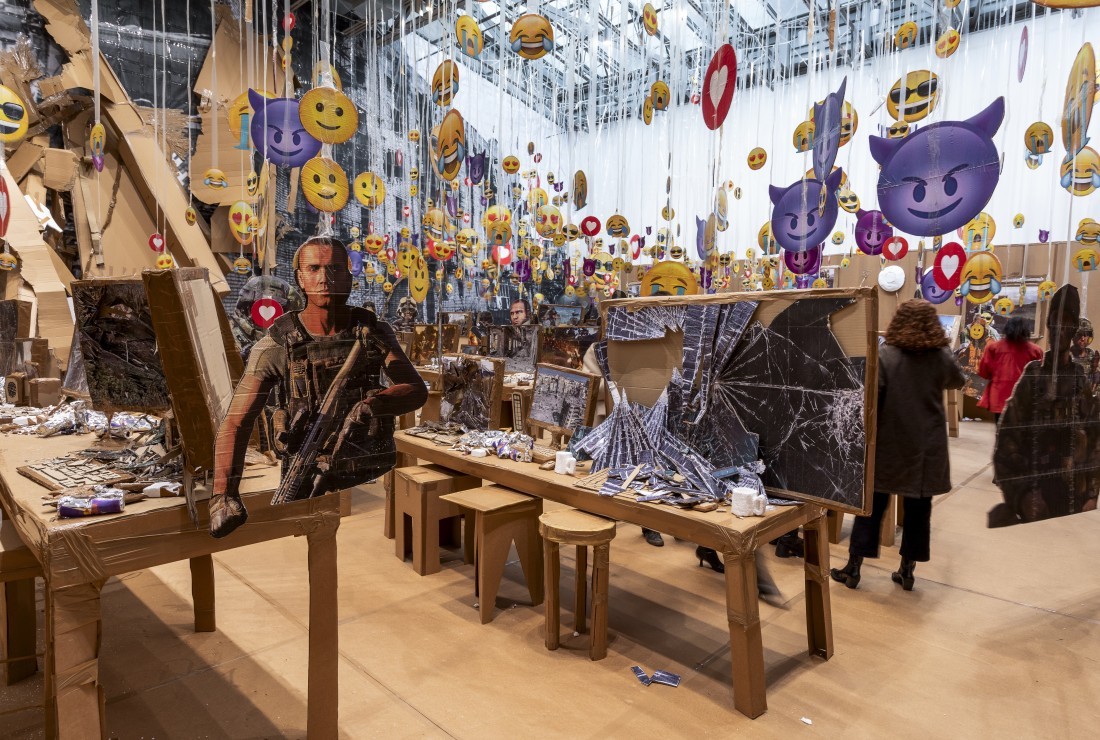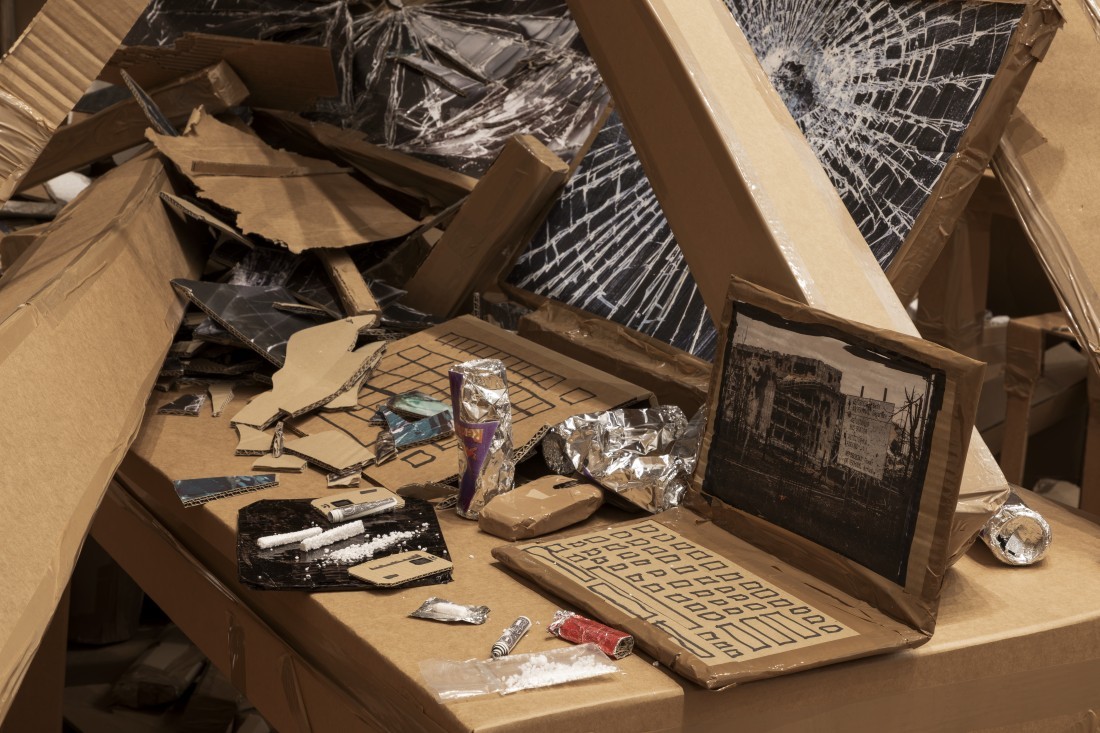Thomas Hirschhorn
Reflecting on Thomas Hirschhorn’s recent exhibition “Fake it, Fake it – till you Fake it.,” I thought of the recent passing of Richard Serra, specifically of his “verb list,” a tally of sculptural approaches to materials (to shorten, to twist, to dapple, to crumple, to shave, to tear … ) so exhaustive that it inclines one to imagine the same relentless force applied not only to materials but to language; after the first flurry of action words, Serra moves to states (of tension, of gravity, of entropy, of nature) that suggest that the real material to be manipulated is, as it must be, imagination. What’s the connection?
Hirschhorn is known for his use of corrugated cardboard, and here it becomes somehow both activity and condition (both “to” and “of”): long rows of roughly constructed cardboard tables and stools fill a space whose floors and walls are likewise lined with the material and held together with polypropylene packing tape. Each table has its own monitor and keyboard, with “precariously made” props such as phones, aluminum foil Red Bull cans, Styrofoam cigarettes and drifts of cocaine. Dangling from the ceiling on long strips of clear tape are giant-sized emojis printed onto (yet more) cardboard. It’s as if a thousand Amazon packages were slaughtered for their hides alone.

Thomas Hirschhorn, installation view, “Fake it, Fake it – till you Fake it.,” 2024, Gladstone Gallery, New York. © Thomas Hirschhorn / Artists Rights Society (ARS), New York. Courtesy the artist and Gladstone Gallery, New York.
Life-size cut-outs of soldiers in action poses are similarly suspended: twisting in and out of peripheral confrontation, hyperbolically macho, they are recognizable as the avatars and non-player characters (NPC) of first-person shooters like Call of Duty. Some of the emojis—approving hearts or perennially ironic “tears of joy”—are stuck to their faces. The mancave-man atavism of gaming consoles and staged litter manspreads into corners piled with unused scraps. Some of the wall space of this capital W “Wasteland” (these fragments I have shored / against my ruins) is papered with low-res black and white images of battle-ravaged sites—Gaza or Mariupol. Unreal City.
Notoriously out spoken, Hirschhorn has stated his distaste for the elegant industrial spaces typical of the mega-galleries of Chelsea, yet he has also repeatedly made use of the Gladstone Gallery to test radical ideas over 20-plus years, in one instance (Cavemanman, from 2002) transforming the space into a Lascaux-like maze. This time, the high-ceilinged room looks cavernous and raw. Spray-painted on one wall is a manifesto: “Dear World, We are talking about ‘Artificial Intelligence’—but why only Intelligence: why not ‘Artificial Willpower?’ ‘Artificial Belief?’ ‘Artificial Faith?’ ‘Artificial Hope?’ ‘Artificial Resistance?’ ‘Artificial Intuition?’, and why not also ‘Artificial Vision?’—the Vision which only our eyes can see? And why not, furthermore, ‘Artificial Disobedience?’ Never give up human competencies other than intelligence: in order to escape robotic control. BE AWARE or BE NEXT!”
There is a quality to Hirschhorn’s rhetoric that invites a distinctive mix of naïveté and cynicism—there is wonderment at the volume and scale of epic bricolage accompanied by grimacing at signifiers for what, in our present state of anxiety, are worried old toys: toxic masculinity, shape-shifting addiction and apocalyptic dread. There is a temptation to abandon interpretation, seeing this expressionistic wreckage as meeting a worst of all possible worlds on its own terms. Hirschhorn can seem dire to a fault, his choice to exhibit at a space like Gladstone just opportunistic punk-rock nihilism pretending to political and philosophical seriousness. This conundrum isn’t new—he has often been compared to both Kurt Schwitters and Joseph Beuys, artists whose commitment to anarchic relationships between materials, forms and social significance has been alternately championed as radically imaginative or dismissed as Romantic fantasia.

Thomas Hirschhorn, “Fake it, Fake it - till you Fake it.,” cardboard, prints, tape, polystyrene, aluminum foil, dimensions variable. Photo: David Regen. © Thomas Hirschhorn / Artists Rights Society (ARS), New York. Courtesy the artist and Gladstone Gallery, New York.
One clue might lie in considering what Hirschhorn champions—for instance, his reverence for visionary formalists like Tatlin and Mondrian, or his repeated, emphatic self-identification as a “form-giver.” The neutrality and availability of his materials and the toy-like immediacy of the objects he makes from them speak to a commitment to simplicity and flexibility as fundamental qualities for sculpture; his history of working with unskilled assistants as a strategy for avoiding preciousness echoes the ethos of Beuys, or another of his heroes, Warhol. The unselfconscious economy of his cardboard iPads with their braided packing-tape charger cords opens them up to play; encountering them en masse creates a curious disjuncture between the conceptual roar of spectacle and the foibles of facture that flag handmade objects; it is a disjuncture that generates the social energy in Hirschhorn’s work, a friction that is ultimately liberating.
In 2005, Village Voice critic Jerry Saltz coined the term “clusterfuck esthetics” to address work by Hirschhorn, Jason Rhoades, Jonathan Meese, Paul McCarthy and others that exceeded through excess: a manic glut of modalities messaging a lumpen lust for disruption. It’s worth noting that the term’s origin in Vietnam War-era military slang refers to a comedy of errors stemming from tactical disaster, as it is within the fields of both tact and disaster that Hirschhorn’s directives are best navigated. His networks of form and meaning bring to mind the “rhizomatic” organization outlined by one of Hirschhorn’s guiding lights, Gilles Deleuze: like ginger roots, a swarm of rats, or an anarcho-terrorist cell, rhizomes comprise a centreless entity guided by a shared collective impulse.
We experience this spatial strategy in the improvisational terrain and nodal flow of “Fake it,” but Hirschhorn also uses this model temporally, revisiting his past strategies with call-backs, twists and bait-and-switches that hint at more fully developed intersections of engagement. This works in part because the character of so many of his chosen subjects—from conflict zones to continental theorists—has changed so little over the 40 years that have defined his career. It’s easy to thematize ways in which algorithm-driven feeds, bite-sized news cycles and protracted “forever wars” have impaired our ability to regard ourselves historically.
Thus, Hirschhorn’s Red Bull cans can readily recall sticks of tinfoil “dynamite” strapped to mannequins—and politicized reading materials—in Cavemanman, and his cardboard soldiers echoing the ethos of camouflage as universal fashion explored in his “UTOPIA, UTOPIA = ONE WORLD, ONE WAR, ONE ARMY, ONE DRESS” (ICA, Boston, 2005). These proximal semblances are, for Hirschhorn’s viewers, something like a “respawn radius” in a video game: a general area from which new chains of signification can be formed from previously exhausted adventures. The manifesto for “UTOPIA” (available on the artist’s website), like the one scrawled on “Fake it”’s cardboard wall, both threatens and exhorts, calling for, in the artist’s words, “a non-pessimistic action”; Fake it, Fake it – till you Fake it may sound almost puerile in its negativity, but its redundancies conceal the shade of an orphaned phrase: make it. ❚
“Fake it, Fake it – till you Fake it.” was exhibited at Gladstone Gallery, New York, from January 24, 2024, to March 2, 2024.
John Luna is a visual artist and poet living on Malahat territory on Vancouver Island. His ongoing project “The Servant” addresses PTSD as experienced by veterans and their families.

